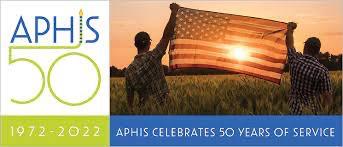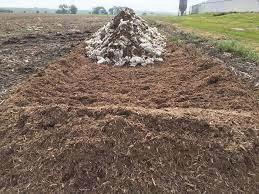 The USDA-Animal Plant and Health Inspection Service (APHIS) celebrates 50 years of service having been founded during April 1972. In a recent edition of the American Veterinarian Medical Association weekly newsletter, Kevin Shea, Director of APHIS, was interviewed regarding past achievements, the current status of the Agency and future prospects. The primary missions of APHIS are to interdict foreign animal diseases at our borders and to control and eliminate exotic infections as and where they occur.
The USDA-Animal Plant and Health Inspection Service (APHIS) celebrates 50 years of service having been founded during April 1972. In a recent edition of the American Veterinarian Medical Association weekly newsletter, Kevin Shea, Director of APHIS, was interviewed regarding past achievements, the current status of the Agency and future prospects. The primary missions of APHIS are to interdict foreign animal diseases at our borders and to control and eliminate exotic infections as and where they occur.
 Shea noted the eradication of bovine brucellosis and Cochliomyia (screwworm) infestation in cattle as two major achievements of the Agency. Advances have been made in suppressing tuberculosis through cooperative federal and state programs. APHIS was instrumental in establishing a surveillance program for bovine spongiform encephalopathy that maitained the export volume of U.S. beef.
Shea noted the eradication of bovine brucellosis and Cochliomyia (screwworm) infestation in cattle as two major achievements of the Agency. Advances have been made in suppressing tuberculosis through cooperative federal and state programs. APHIS was instrumental in establishing a surveillance program for bovine spongiform encephalopathy that maitained the export volume of U.S. beef.
It was ironic that that when APHIS was developed from the then USDA Bureau of Animal Management, it was involved in eradication of exotic Newcastle disease (END) then referred to as VVND. Fifty years later, APHIS is dealing with the tail of the third serious epornitic of Highly Pathogenic Avian Influenza (HPAI) since inception of the Agency. Effectively, control and eradication of catastrophic poultry diseases is unchanged over 50 for a half-century. The approach comprises rapid diagnosis, flock depletion and disposal, creating areas of zone surveillance with quarantine and restrictions of movement. Diagnostic technology has improved from the dependence on hemagglutination serology and viral isolation with identification in SPF embryos. The current approach applies immuno-based techniques including lateral flow immunodiffusion for rapid screening of suspect flocks, followed by PCR in regional laboratories to confirm a diagnosis, accelerating the process of flock depletion and concurrent control measures.
With each succeeding HPAI epornitic, APHIS has demonstrated a faster response due to preemptive contingency planning and organization. More resources in the form of qualified and trained personnel are available for field deployment. With respect to floor-housed flocks, mass euthanasia using carbon dioxide foam has expedited flock depletion. To date APHIS has not developed a simple, rapid method of depleting cage and aviary-housed flocks other than enhanced VSD. This deficiency represents the greatest challenge with respect to numbers of birds on affected large complexes with the potential to disseminate virus to adjacent complexes and farms.
 Administrator Shea pointed to the change in training of professional personnel over 50 years. He noted that the Agency has moved from recruiting veterinarians from private practice in mid-career to more recent graduates with training in infectious disease epidemiology. This is evident from webinars presented by APHIS, but it is questioned as to whether their role could become more proactive. The 2022 outbreak of HPAI is the issue in contention. Highly Pathogenic Avian Influenza in commercial flocks in the U.S. was preceded by isolation of the predominant H5N1 strain in free-living birds in the Maritime Provinces at the turn of the year and followed by an extension southward from Maine to Florida over succeeding weeks.
Administrator Shea pointed to the change in training of professional personnel over 50 years. He noted that the Agency has moved from recruiting veterinarians from private practice in mid-career to more recent graduates with training in infectious disease epidemiology. This is evident from webinars presented by APHIS, but it is questioned as to whether their role could become more proactive. The 2022 outbreak of HPAI is the issue in contention. Highly Pathogenic Avian Influenza in commercial flocks in the U.S. was preceded by isolation of the predominant H5N1 strain in free-living birds in the Maritime Provinces at the turn of the year and followed by an extension southward from Maine to Florida over succeeding weeks.
The initial outbreaks in large-egg production complexes occurred at the end of February in Delaware along the Atlantic Flyway. In mid-March, outbreaks occurred in Iowa and Wisconsin presumably from migratory birds transitioning the Mississippi Flyway and prevailing through the beginning of April with a case requiring extensive depletion in Nebraska. A cluster of cases then occurred in mid-April in Lancaster County, Pennsylvania. The Central Flyway was involved in late April and again, in early June in Colorado. As of June 6th, 31.4 million laying hens have been depleted in 24 locations in nine states.
The fact that the 2022 strain of H5N1 carried Eurasian genes suggested transfer of the virus from Northern Europe through the island nations of the North Atlantic to the Canadian Province of Newfoundland and Labrador. Given that HPAI is transmitted by free-living birds, most of which are clinically unaffected, requires a radical change in APHIS strategy. It is now no longer possible to exclude this disease at our borders an approach that is appropriate for exotic diseases of hogs including ASF or foot and mouth infection in cattle.
It is a matter of record that as early as late March EGG-NEWS suggested that APHIS provide a preliminary review of epidemiologic factors relating to outbreaks among the initial cases in large-egg production complexes. As of mid-April, almost 20 million hens had been depleted in seven complexes. Surely, results of an initial evaluation, including whole genome sequencing of isolates and a preliminary case-controlled study could have been performed with interim results available to the industry. Any obvious findings could have been applied to possibly prevent subsequent outbreaks based on identified deficiencies in biosecurity. It was clearly stated at the time that an interim report would be of more value in mid-April 2022 than a comprehensive study in 2024. Even as the 2022 epornitic appears to be at an end corresponding to the same week of the year as the previous 2015 event, there is still reliance on the same basic biosecurity measures based on traditional and heuristic principles. Obvious questions relating to future control and prevention include:-
- Infectivity of the H5N1 strain of the virus for various commercial poultry species and molecular characteristics of the 2020 strain carrying Eurasian genes,
- Routes of introduction into a specific area,
- Methods of introduction onto complexes and farms for diverse poultry species,
- Why many at-risk complexes were unaffected despite high risk of exposure
- The range and role of airborne transmission,
- Persistence of virus in the environment,
- Possibility of endemic wild birds and mammals serving as future reservoir populations.
Guidance from the APHIS based on value judgment opinions derived from preliminary field and laboratory epidemiology, may have provided practical suggestions to prevent additional outbreaks during late April through early June. Although the poultry industry recognizes the achievements of APHIS over the past, it must be recognized that the approach of the Agency to any catastrophic disease of poultry including END and HPAI has not altered since 1972.
Given the development and application of DNA vaccines, currently being evaluated in France and vector vaccines deployed in Egypt and Mexico, APHIS, in collaboration with USDA-ARS, the biopharmaceutical industry, the World Organization for Animal Health (WOAH=OIE) and academia should prepare for the next HPAI epornitic involving the uapplication of immunization. The poultry industry and specifically the egg production segment, requires a rapid and comprehensive epidemiologic study in order to correct any defects in biosecurity or industry practices in advance of the next outbreak. Although we were relatively unaffected between 2015 and 2022, there is no assurance, given changes in the virus and the pattern of distribution by migratory waterfowl and seabirds, that we will not be facing additional epornitics in 2023 and succeeding years.
The sentiments expressed by Administrator Shea indicate a future for APHIS characterized by the introduction of a higher level of technology. This will be welcome to the poultry sector, given the immense cost of controlling and eradicating HPAI. The infection can no longer be regarded as exotic but is now seasonally endemic following introduction by migratory birds in the E.U and North America. Given the changed epidemiology of the disease, APHIS should adapt and make use of all available resources to respond to future challenges. The past 50-years is now history. We look to APHIS for innovation as the challenges of exotic diseases intensify and the financial and supply-chain consequences of infection become more apparent.